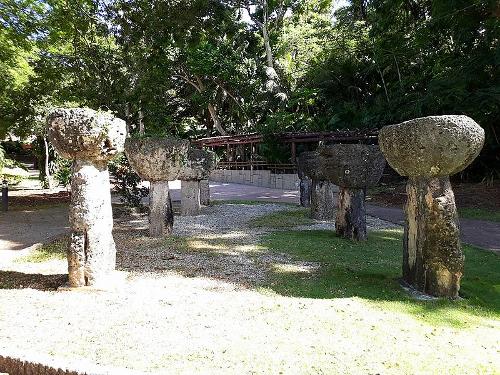GUAM
History

History
History
Early history
 Guam LattesPhoto: Abner T Brennan CC 4.0 International no changes made
Guam LattesPhoto: Abner T Brennan CC 4.0 International no changes made
The history of Guam is inextricably linked to the history of the Mariana Islands. These islands were already inhabited by the Chamorro at the earliest in 1500 BC. These early inhabitants most probably came from Indonesia. The fact that they were the only people in Micronesia to grow rice is a strong indication in this direction. The most important remains of these early times are the so-called "lattes", megalithic stones up to six metres high, which were probably part of traditional Micronesian buildings. The social system consisted of three classes, the matua (nobles), the achoat (half nobles), and the manachang, fishermen and farmers. Guam was then divided into districts consisting of a few villages, mainly located along the coast. Each district was led by a "chamorri"; there was no central authority. This of course often led to conflicts between the various districts.
Spanish rule
The first western contact dates back to 6 March 1521 when Ferdinand Magelhaes entered Utamac Bay on Guam with the ship Trinidad. The Mariana Islands were initially called "Islas de las Velas Latinas", after the sails the Chamorro had on their canoes, which were much better than those the Spanish used on their ships. The name of the island of Guam derives from the local Guahan, meaning 'we have'. Magelhaes immediately came into conflict with the Chamorro (seven dead), something that would happen many times more.
In 1565, Miguel Lopez de Legazpi arrived and officially claimed the Mariana Islands on behalf of Spain, and went on to exploit the lucrative trade route between the Philippines and Mexico. However, it would be another 150 years before attempts were made to establish a European settlement on Guam. For the next 250 years, Spanish galleons in particular stopped off to stock up on provisions. Spanish, English and Dutch explorers also visited Guam. In 1668, the Jesuit Diego Luis de Sanvitores arrived on Guam and founded a mission post in Hagåtña. The Chamorro were initially receptive to the missionaries' stories, but when they realised they were losing their own culture and customs, two decades of wars and unrest followed. Sanvitores was killed in 1672.
By 1690, the fighting had ended and the Chamorro population had been decimated; only 5,000 of the 100,000 remained. The smallpox and flu brought by the Spaniards also cost many their lives. Women and children were the only ones left. In order to restore the population, Spanish soldiers and men from the Philippines married the Chamorro women. In this way, much of the Chamorro culture was still lost. The Spaniards also introduced writing, founded schools and taught the Chamorro new building and agricultural methods.
Whalers had been visiting the Mariana Islands since 1798. It was not until 1822 that they docked off the coast of Guam. Some were English, but most were American. The 1940s were the high point in this regard, when hundreds of whalers passed through Guam's waters.
Guam taken over by the United States
In 1898, the United States declared war on Spain. The Spanish authorities on Guam, however, knew nothing about it, so the Americans had no trouble capturing Guam and the United States gained an important military foothold. At the Peace of Paris, Guam was given to the United States alongside Puerto Rico and the Philippines.
Until the end of the 1930s, Guam was administered by the US Navy (after 1950 under the Interior). From February 1941, Guam was allowed by the then President of the United States, Franklin D. Roosevelt, to be visited only with the permission of the authorities. This status lasted until August 1962.
Second World War
On 8 December 1941, Guam was bombed by the Japanese, on the same day as Pearl Harbor on Hawaii. On 10 December approximately 5000 Japanese soldiers took the island. It was totally undefended by the Americans. The few inhabitants were taken prisoner, sent to Japanese labour camps and they started learning the Japanese language. The Japanese called the island Omiyajima. At the beginning of the occupation, the Chamorro population was left reasonably alone. However, towards the end of the Japanese occupation, they had to start working for the Japanese, including building defence forts for the Japanese. On 12 July 1944, all Guamanians were transported to concentration camps on the east coast. Their fate was uncertain at the time, but if they had stayed, there would surely have been many deaths among the population during the preliminary bombardments and the invasion by the Americans. Nevertheless, at the end of the war, several war crimes were still committed by the Japanese. The bombing for the invasion started on 17 July 1944. Four days later, 55,000 American soldiers landed on the beaches of Guam. On 10 August Guam was liberated from the Japanese. In the end, 17,500 Japanese and 7,000 Americans died. Hagåtnña and many other villages were destroyed.
In the weeks after the liberation, Guam was overrun by about 200,000 American soldiers, who were prepared for an invasion of Japan. About one third of the island was claimed by the military. After the war, the military retained these areas and settled them permanently. Guam therefore also played a significant role in the Korean War and later in the Vietnam War. In 1986, after a court case, landowners were finally awarded damages running into millions of dollars. With more and more foreign military bases being closed by the Americans, the Chamorro are hoping to get their land back.
Sources
Galbraith, K. / Micronesia
Lonely Planet
Levy, N. / Micronesia handbook
Moon
CIA - World Factbook
BBC - Country Profiles
Copyright: Team The World of Info